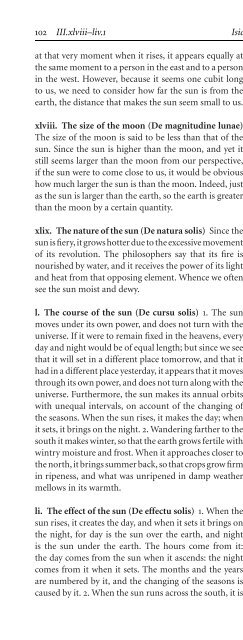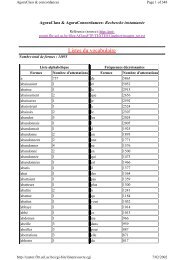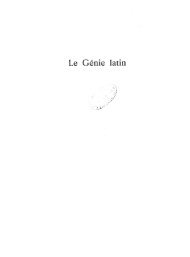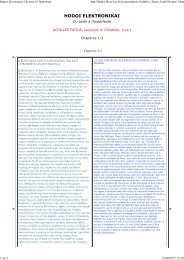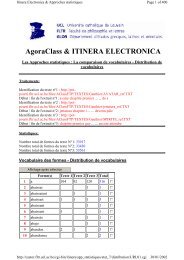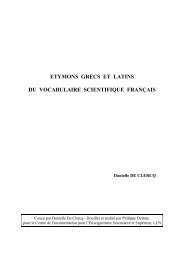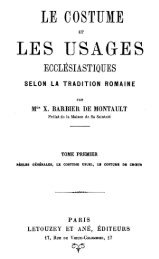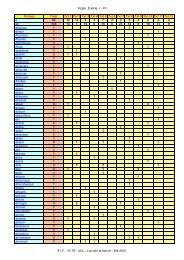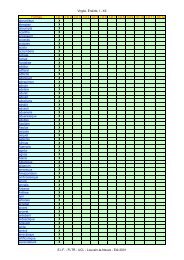The Etymologies of Isidore of Seville - Pot-pourri
The Etymologies of Isidore of Seville - Pot-pourri
The Etymologies of Isidore of Seville - Pot-pourri
Create successful ePaper yourself
Turn your PDF publications into a flip-book with our unique Google optimized e-Paper software.
102 III.xlviii–liv.1 <strong>Isidore</strong> <strong>of</strong> <strong>Seville</strong><br />
at that very moment when it rises, it appears equally at<br />
the same moment to a person in the east and to a person<br />
in the west. However, because it seems one cubit long<br />
to us, we need to consider how far the sun is from the<br />
earth, the distance that makes the sun seem small to us.<br />
xlviii. <strong>The</strong> size <strong>of</strong> the moon (De magnitudine lunae)<br />
<strong>The</strong> size <strong>of</strong> the moon is said to be less than that <strong>of</strong> the<br />
sun. Since the sun is higher than the moon, and yet it<br />
still seems larger than the moon from our perspective,<br />
if the sun were to come close to us, it would be obvious<br />
how much larger the sun is than the moon. Indeed, just<br />
as the sun is larger than the earth, so the earth is greater<br />
than the moon by a certain quantity.<br />
xlix. <strong>The</strong> nature <strong>of</strong> the sun (De natura solis) Sincethe<br />
sun is fiery, it grows hotter due to the excessive movement<br />
<strong>of</strong> its revolution. <strong>The</strong> philosophers say that its fire is<br />
nourished by water, and it receives the power <strong>of</strong> its light<br />
and heat from that opposing element. Whence we <strong>of</strong>ten<br />
see the sun moist and dewy.<br />
l. <strong>The</strong> course <strong>of</strong> the sun (De cursu solis) 1. <strong>The</strong>sun<br />
moves under its own power, and does not turn with the<br />
universe. If it were to remain fixed in the heavens, every<br />
day and night would be <strong>of</strong> equal length; but since we see<br />
that it will set in a different place tomorrow, and that it<br />
had in a different place yesterday, it appears that it moves<br />
through its own power, and does not turn along with the<br />
universe. Furthermore, the sun makes its annual orbits<br />
with unequal intervals, on account <strong>of</strong> the changing <strong>of</strong><br />
the seasons. When the sun rises, it makes the day; when<br />
it sets, it brings on the night. 2.Wandering farther to the<br />
south it makes winter, so that the earth grows fertile with<br />
wintry moisture and frost. When it approaches closer to<br />
the north, it brings summer back, so that crops grow firm<br />
in ripeness, and what was unripened in damp weather<br />
mellows in its warmth.<br />
li. <strong>The</strong> effect <strong>of</strong> the sun (De effectu solis) 1. Whenthe<br />
sun rises, it creates the day, and when it sets it brings on<br />
the night, for day is the sun over the earth, and night<br />
is the sun under the earth. <strong>The</strong> hours come from it:<br />
the day comes from the sun when it ascends: the night<br />
comes from it when it sets. <strong>The</strong> months and the years<br />
are numbered by it, and the changing <strong>of</strong> the seasons is<br />
caused by it. 2.Whenthe sun runs across the south, it is<br />
the closer to the earth; but when it is near the north, it<br />
is raised higher in the sky.<br />
[Thus God made diverse locations and seasons for<br />
the sun’s course, so that it does not consume everything<br />
with its daily heat by always tarrying in the same place.<br />
But, as Clement said, “<strong>The</strong> sun takes diverse paths, by<br />
means <strong>of</strong> which the temperature <strong>of</strong> the air is meted out<br />
according to the pattern <strong>of</strong> the seasons, and the order <strong>of</strong><br />
its changes and permutations is preserved. Thus when<br />
the sun ascends to the higher reaches, it tempers the<br />
spring air; when it reaches its zenith, it kindles the summer<br />
heat; dropping again it brings back the temperance<br />
<strong>of</strong> autumn. But when it goes back to the lowest orbit, it<br />
bequeaths to us from the icy framework <strong>of</strong> the sky the<br />
rigor <strong>of</strong> winter cold.”] 31<br />
lii. <strong>The</strong> path <strong>of</strong> the sun (De itinere solis) <strong>The</strong> sun, when<br />
it rises, holds a path through the south. Afterward, it<br />
goes to the west and plunges itself into the Ocean, and it<br />
travels unknown paths under the earth, and once again<br />
runs back to the east.<br />
liii. <strong>The</strong> light <strong>of</strong> the moon (De lumine lunae) 1. Some<br />
philosophers say that the moon has its own light; that<br />
one part <strong>of</strong> its orb emits light and the other is dark<br />
[thus: (a figure follows)] and that by gradually turning<br />
itself it makes different shapes. 2. Others maintain on<br />
the contrary that the moon does not have its own light,<br />
but is illuminated by the rays <strong>of</strong> the sun, and for this<br />
reason undergoes an eclipse when the earth’s shadow<br />
comes between it and the sun. [For the sun is located<br />
higher than the moon. Hence it happens that when the<br />
moon is beneath the sun, the upper part <strong>of</strong> the moon is<br />
lighted, but the lower part, which is facing the earth, is<br />
dark.]<br />
liv. <strong>The</strong> shapes <strong>of</strong> the moon (De formas lunae) 1. <strong>The</strong><br />
first shape <strong>of</strong> the moon has two horns, thus: (a figure<br />
follows). <strong>The</strong> second [has] a section, [thus:] (fig.). <strong>The</strong><br />
31 <strong>The</strong> quotation is from Rufinus Tyrannius’s translation <strong>of</strong> the<br />
Clementine Recognitions, 8.45.Acircular figure follows in some early<br />
manuscripts. It has in its center the words medium mundi, i.e. the<br />
“center <strong>of</strong> the universe,” and around it the stations <strong>of</strong> the sun are<br />
written thus: “here is the sunrise on the nativity <strong>of</strong> the Lord; the<br />
sixth hour <strong>of</strong> the day; sunset on the nativity <strong>of</strong> the Lord; sunset on<br />
the equinox; sunset on the nativity <strong>of</strong> John; perpetual midnight;<br />
sunrise on the nativity <strong>of</strong> John; here is the sunrise on the equinox.”


